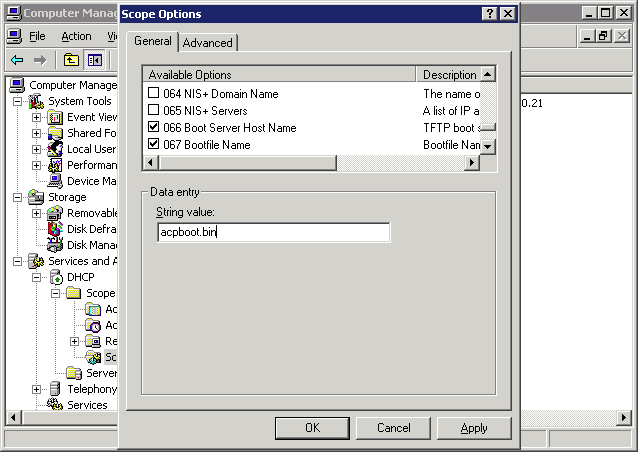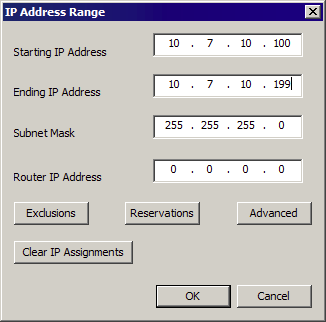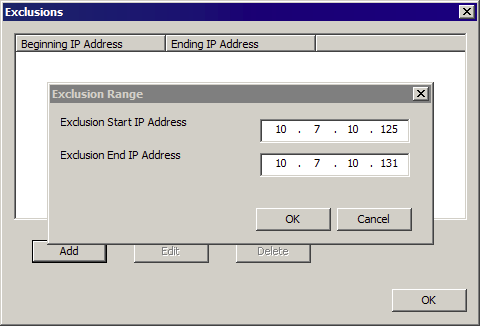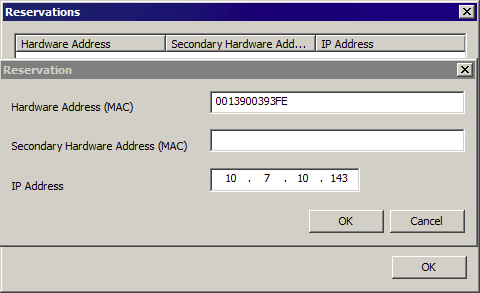|
If you would like to speak with one of our engineers, please Submit a Question or give us a call at the phone number here. In North America, To route your phone support request directly to a technical support engineer, call toll-free 1-888-382-1583 or 1-440-646-3434, select Option 3 (Technical Support), then select Option 5 (More Options). When prompted, enter the ThinManager Direct Dial Code 201. |
Difference between revisions of "ThinManager and PXE Boot"
| Line 27: | Line 27: | ||
| Boot File Name||ThinManager||DHCP Option 067||ThinManager | | Boot File Name||ThinManager||DHCP Option 067||ThinManager | ||
|} | |} | ||
| − | <center> | + | <center>[[File:TMPXE1.png|PXE Server Modes on PXE Server Wizard]]<br>''PXE Server Modes on PXE Server Wizard''<br></center> |
| − | [[File:TMPXE1.png|PXE Server Modes on PXE Server Wizard]] | ||
| − | <br> | ||
| − | ''PXE Server Modes on PXE Server Wizard'' | ||
| − | <br></center> | ||
The '''PXE Server Wizard''' is opened by selecting Manage > PXE Server from the ThinManager menu. | The '''PXE Server Wizard''' is opened by selecting Manage > PXE Server from the ThinManager menu. | ||
==Using Standard DHCP Server== | ==Using Standard DHCP Server== | ||
| Line 50: | Line 46: | ||
*Scroll to Option 066 Boot Server Host Name, check the check box, and enter the IP address of the ThinManager Server in the String Value field. If you use a redundant pair of ThinManager Servers enter both IP addresses separated by a space. | *Scroll to Option 066 Boot Server Host Name, check the check box, and enter the IP address of the ThinManager Server in the String Value field. If you use a redundant pair of ThinManager Servers enter both IP addresses separated by a space. | ||
*Scroll to Option 067 Bootfile Name, check the check box, and enter “acpboot.bin” in the String Value field. | *Scroll to Option 067 Bootfile Name, check the check box, and enter “acpboot.bin” in the String Value field. | ||
| − | [[File:TMPXE2.png|DHCP Scope Options]] | + | <center>[[File:TMPXE2.png|DHCP Scope Options]] |
<br> | <br> | ||
''DHCP Scope Options'' | ''DHCP Scope Options'' | ||
| Line 95: | Line 91: | ||
*Enter the MAC address from the ThinManager Compatible thin client in the Hardware Address (MAC) field. Enter a secondary MAC if it has two NICs. These are often on the serial number label. | *Enter the MAC address from the ThinManager Compatible thin client in the Hardware Address (MAC) field. Enter a secondary MAC if it has two NICs. These are often on the serial number label. | ||
*Enter the IP address you want to assign to it in the IP Address fields and click the OK button. | *Enter the IP address you want to assign to it in the IP Address fields and click the OK button. | ||
| − | [[File:TMPXE4.png|Reservation Window in the PXE Server]] | + | <center>[[File:TMPXE4.png|Reservation Window in the PXE Server]] |
| − | <br> | + | <br>''Reservation Window in the PXE Server''<br></center> |
| − | ''Reservation Window in the PXE Server'' | ||
| − | <br></center> | ||
===Reservations in the Terminal Configuration Wizard:=== | ===Reservations in the Terminal Configuration Wizard:=== | ||
It is easier to assign reservations in the Terminal Configuration Wizard after a terminal has connected to | It is easier to assign reservations in the Terminal Configuration Wizard after a terminal has connected to | ||
| Line 106: | Line 100: | ||
**The MAC address is shown in the Terminal ID and IP Address field. | **The MAC address is shown in the Terminal ID and IP Address field. | ||
*Select the Edit button to launch the Edit Terminal ID window. | *Select the Edit button to launch the Edit Terminal ID window. | ||
| − | [[File:TMPXE5.png|Edit Terminal ID Window]] | + | <center>[[File:TMPXE5.png|Edit Terminal ID Window]]<br>''Edit Terminal ID Window''<br></center> |
| − | <br> | ||
| − | ''Edit Terminal ID Window'' | ||
| − | <br></center> | ||
The MAC address is entered automatically. | The MAC address is entered automatically. | ||
*Check the Statically assign IP Address checkbox. | *Check the Statically assign IP Address checkbox. | ||
Revision as of 20:16, 31 October 2012
A thin client in a ThinManager system needs three components to boot:
- A client IP address to join the network
- The IP address of a ThinManager Server to get its configuration
- The firmware or boot file to load the thin client image.
A ThinManager Ready thin client can use DHCP or static for the client IP address and the ThinManager Server IP address. Its BIOS will instruct it to download the firmware.
ThinManager Compatible thin clients do not store static IP addresses so each of them require DHCP (Dynamic Host Configuration Protocol) to assign the client IP address. The ThinManager Server IP address and bootfile name can be provided by a DHCP server or by the ThinManager PXE Server.
Contents
PXE Server Modes
There are three modes or methods that a ThinManager Compatible thin client can receive this information.
Using standard DHCP server
This mode will allow the client to use an existing DHCP server to provide the client IP address while the ThinManager PXE server will provide the ThinManager IP and boot file name.
Using standard DHCP server with Boot Options
This mode allows the DHCP server to provide all the information needed. It will use Option 066 to provide the ThinManager IP and will use Option 067 to provide the boot file name in addition to the client IP address.
Not using standard DHCP Server
This gives ThinManager the power to provide all the necessary information, including client IP addresses.
| PXE Server Modes | |||
|---|---|---|---|
| Standard DHCP | DHCP with Boot Options | Not Using Standard DHCP | |
| Client IP | DHCP Server | DHCP Server | Addresses in ThinManager |
| ThinManager IP | ThinManager | DHCP Option 066 | ThinManager |
| Boot File Name | ThinManager | DHCP Option 067 | ThinManager |

PXE Server Modes on PXE Server Wizard
The PXE Server Wizard is opened by selecting Manage > PXE Server from the ThinManager menu.
Using Standard DHCP Server
The Using standard DHCP server mode is used when you have an existing DHCP server in your system to pass out the IP addresses. In ThinManager:
- Select Manage > PXE Server to open the PXE Server Wizard.
- Select the Enable PXE Server checkbox on the PXE Server Configuration page.
- Select the Using standard DHCP server radio button on the Network Interface Configuration page.
- Select the Finish button and the PXE server is configured.
The ThinManager Compatible thin client will make a DHCP request when it is turned on. The DHCP server will respond with the client IP address. The ThinManager will respond with the PXE boot information and the thin client will connect to ThinManager.
Using Standard DHCP Server with Boot Options
The Using standard DHCP server mode is used when you have an existing DHCP server and want it to provide all the information. On the DHCP Server:
- Open the Microsoft DHCP Service by selecting Start > Administrative Tools > Computer Management on your Microsoft DHCP server.
- Right click on the Scope Options in the Scope tree and select Configure Options.
- Scroll to Option 066 Boot Server Host Name, check the check box, and enter the IP address of the ThinManager Server in the String Value field. If you use a redundant pair of ThinManager Servers enter both IP addresses separated by a space.
- Scroll to Option 067 Bootfile Name, check the check box, and enter “acpboot.bin” in the String Value field.

DHCP Scope Options
In ThinManager:
- Select Manage > PXE Server to open the PXE Server Wizard.
- Select the Enable PXE Server checkbox on the PXE Server Configuration page.
- Select the Using standard DHCP server with Boot Options radio button on the Network Interface Configuration page.
- Select the Finish button and the PXE server is configured.
The ThinManager Compatible thin client will make a DHCP request when it is turned on. The DHCP server will respond with the client IP address, the ThinManager address, and the name of the bootfile to download. The ThinManager Compatible thin client will connect to ThinManager.
Not Using Standard DHCP Server
The Not using standard DHCP server mode is used when you do not have an existing DHCP server. This mode is configured to give ThinManager the ability to pass all the information needed to boot.
In ThinManager:
- Select Manage > PXE Server to open the PXE Server Wizard.
- Select the Enable PXE Server checkbox on the PXE Server Configuration page.
- Select the Not using standard DHCP radio button on the Network Interface Configuration page.
- Select the Next button to navigate to the IP Address Range Configuration page.
The ThinManager Server needs to have a range of IP addresses added so that it can give the ThinManager Compatible thin client their IP addresses.

IP Address Range Window
</center>
Select the Add button on the IP Address Range Configuration page to launch the IP Address Range window.
- Enter the first IP address of the range in the Starting IP Address fields.
- Enter the last IP address of the range in the Ending IP Address fields.
Exclusions
Exclusions, IP addresses not to be assigned, can be configured by selecting the Exclusions button to launch the Exclusions window.

Exclusions Window and Exclusion Range Window
</center>
Select the Add button on the IP Address Range Configuration page to launch the IP Address Range window.
- Select the Exclusions button to launch the Exclusion window.
- Select the Add button to launch the Exclusion Range window.
- Enter the range of IP addresses to exclude from assignment by putting the first and last IP address in the Exclusion Start IP Address and Exclusion Stop IP Address fields and click the OK button.
- If you are excluding a single IP address then enter it in the Exclusion Start IP Address field and click the OK button.
Reserverations
Reservations allows you to assign a specific IP address to a thin client each time it boots. This can be done in the PXE Server or in the Terminal Configuration Wizard. Reservations in the PXE Server:
- Select the Add button on the IP Address Range Configuration page to launch the IP Address Range window.
- Select the Reservations button to launch the Reservations window.
- Select the Add button to launch the Reservation window.
- Enter the MAC address from the ThinManager Compatible thin client in the Hardware Address (MAC) field. Enter a secondary MAC if it has two NICs. These are often on the serial number label.
- Enter the IP address you want to assign to it in the IP Address fields and click the OK button.

Reservation Window in the PXE Server
Reservations in the Terminal Configuration Wizard:
It is easier to assign reservations in the Terminal Configuration Wizard after a terminal has connected to ThinManager because it will register the MAC address for you.
- Double click on the desired terminal in the ThinManager tree to open the Terminal Configuration Wizard.
- Select the Next button to navigate to the Terminal Hardware page.
- The MAC address is shown in the Terminal ID and IP Address field.
- Select the Edit button to launch the Edit Terminal ID window.

Edit Terminal ID Window
The MAC address is entered automatically.
- Check the Statically assign IP Address checkbox.
- Enter the IP address you wish to use in the Static IP Address field.
- Select the OK button to close the window and the Finish button to close the Terminal Configuration Wizard.
Multiple PXE Servers
The PXE boot environment is meant for a single PXE server. Normally having several PXE servers will cause problems as you won’t be able to control which PXE server is responding to the PXE request. Fortunately ThinManager has the Allow New PXE clients feature that allows the use of multiple PXE servers. It does require that only one has the Allow New PXE clients feature active at a time.
You can have a location that uses multiple ThinManagers with PXE servers but you will need to do the initial configurations one zone at a time.
Step One
- Configure your first ThinManager or redundant ThinManager pair. Configure the PXE Server to use either the Using standard DHCP server or Not using standard DHCP Server mode in ThinManager.
- Add all the ThinManager Compatible thin clients for that zone and finalize their configuration.
- Un-select the Allow New PXE clients checkbox on the Network Interface Configuration page. This will prevent any new ThinManager Compatible thin client from booting from this server.
Step Two:
- Configure the second ThinManager or redundant ThinManager pair. Configure the PXE Server to use either the Using standard DHCP server or Not using standard DHCP Server mode in ThinManager.
- Add all the ThinManager Compatible thin clients for the second zone and finalize their configuration. When the ThinManager Compatible thin clients boot the PXE server on the first ThinManager Server will ignore then and they will connect to the second ThinManager Server.
- Un-select the Allow New PXE clients checkbox on the Network Interface Configuration page. This will prevent any new ThinManager Compatible thin client from booting from this server.
Step Three:
- Configure the third ThinManager or redundant ThinManager pair. Configure the PXE Server to use either the Using standard DHCP server or Not using standard DHCP Server mode in ThinManager.
- Add all the ThinManager Compatible thin clients for the third zone and finalize their configuration. When the ThinManager Compatible thin clients boot the PXE server on the first and second ThinManager Server will ignore then and they will connect to the third ThinManager Server.
- Un-select the Allow New PXE clients checkbox on the Network Interface Configuration page. This will prevent any new ThinManager Compatible thin client from booting from this server.
- Repeat as necessary.
Replacing or Adding New Clients:
Since each ThinManager PXE Server will only respond to a specific list of thin clients, the thin clients can all reboot at the same time but only get a response from the appropriate ThinManager Server.
- To add a new terminal or do a replacement you need to allow replacements by selecting the Allow New PXE clients checkbox on the intended ThinManager Server.
- Once the new ThinManager Compatible thin client is added un-check the Allow New PXE clients checkbox again.
Note: Using standard DHCP server with Boot Options does not allow multiple PXE Servers as the DHCP server sends all units the same information.